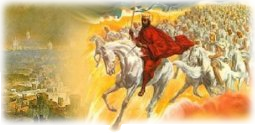Contents
THE latter half of the book of Revelation is very strangely divided into chapters, in the common version of the Bible; in fact, if these chapter divisions are regarded, the most important point is lost from each subject.
1. Revelation 13 extends to 14
Notice: In the thirteenth chapter are given the beast and his image, and their wrath against the remnant; but the division of the chapter where it is divided spoils much, because it entirely cuts off the record of victory.
The thirteenth chapter closes with the beast and his image pouring out their united wrath upon all who will not worship them. But as God gave it, the story goes right on, saying,
Revelation 14
1 And I looked, and lo, a Lamb stood on the mount Sion, and with him a hundred forty and four thousand, having his Father’s name written in their foreheads.
Thus the Lord gives us not only the beast and the image, but also the victory of the faithful, over them. And the fifth verse of the fourteenth chapter shows these faithful ones “without fault before the throne of God.”
2. Revelation 14 extends to 15
At the sixth verse of the fourteenth chapter, begins another view of the same subject, which really ends only in the fifteenth chapter, as the victors over the beast and his image stand on Mount Zion, having the harps of God, and singing the song of Moses and the Lamb; but which, by the unfortunate division of the chapter, is made to end so as to disconnect from the contest all record of the victory of the faithful.
3. Revelation 15 to 18 extend to 19
Then the rest of the fifteenth chapter, and the sixteenth, seventeenth, and eighteenth chapters give the plagues and the judgments upon great Babylon; and again the true culmination is lost by separating the victory of the faithful, setting it over in the nineteenth chapter:
Revelation 19
1 …a great voice of much people in heaven,…
6 …saying, Alleluia; for the Lord God omnipotent reigns.
4. Revelation 19 extends to 20
Next, at the eleventh verse of the nineteenth chapter, is begun the account of the coming of the Lord with the armies of heaven, and the destruction of the kings of the earth and their armies, and of the beast and the false prophet; the binding of Satan, and the triumph of the saints in the first resurrection, and their sitting on thrones of judgment. Yet the direct and interesting connection is broken by the division of the twentieth chapter where it is.
Then come the thousand years, then the resurrection of the wicked, the judgment of Satan and all the wicked, and their destruction in the lake of fire; and then the new heaven and the new earth, and the triumph of all the saints in the new earth and in the New Jerusalem and in the presence of God forevermore.
Thus the first half of the book of Revelation, by three separate accounts [the churches, seals, and trumpets], brings us to the time of the beast and his image; and the remaining portion of the book sketches a series of contests of the beast and his image with the people of God; yet out of the contest come the people of God in triumph every time. Bless the Lord.
Other articles by A. T. Jones:
- That Faithful Saying
- The Work for This Time
- Human Nature and Its Restraints
- The Two Principles
- Dishonest Giving
- Origin of the Doctrine of Natural Immortality
- The Mission of the Spirit
- The One Example
- The Education of Daniel
- The Great Apostate Powers
- Church History in the Book of Revelation
- A Complete Saviour
- Ministers of God
- Consecration
- Christ Revealed in the Sabbath





Thank you so much for this excellent information. God bless you. :)) Kathy C